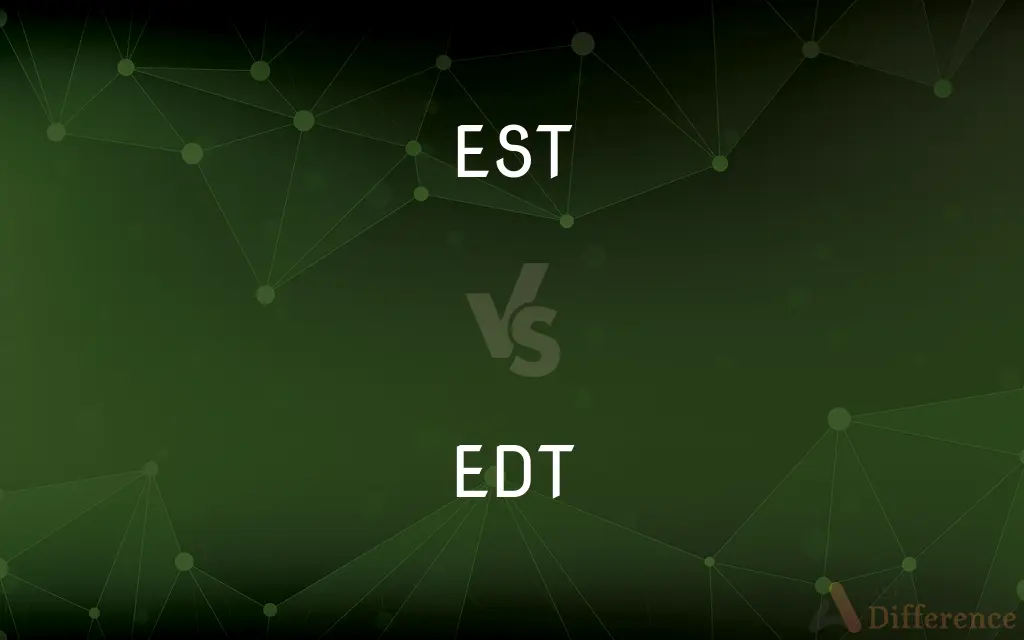EST vs. EDT — What's the Difference?
By Tayyaba Rehman — Published on October 5, 2023
EST stands for Eastern Standard Time, while EDT refers to Eastern Daylight Time, which is EST plus one hour due to daylight saving time.

Difference Between EST and EDT
Table of Contents
ADVERTISEMENT
Key Differences
EST and EDT are both time zones utilized within the Eastern Time Zone of the United States and parts of Canada. EST stands for Eastern Standard Time and is 5 hours behind Coordinated Universal Time (UTC-5). On the other hand, EDT, which signifies Eastern Daylight Time, is UTC-4, 4 hours behind Coordinated Universal Time.
Daylight Saving Time (DST) introduces the distinction between EST and EDT. When DST is not in effect, the Eastern Time Zone follows EST. However, during DST, which typically begins on the second Sunday of March and ends on the first Sunday of November, EDT is observed.
EST and EDT have practical implications for daily activities and planning. For example, television shows might be broadcasted at 8 PM EST during standard time and 8 PM EDT during daylight saving time. It's vital for individuals and businesses to be aware of the switch to ensure accuracy in scheduling and communications.
Though EST and EDT both pertain to the Eastern Time Zone, the terms shouldn't be used interchangeably. Using the incorrect term can lead to confusion, especially in professional settings or when coordinating events. As a rule of thumb, always be attentive to the time of year and ensure you're referencing the correct time designation.
Comparison Chart
Full Form
Eastern Standard Time
Eastern Daylight Time
ADVERTISEMENT
UTC Offset
UTC-5
UTC-4
Period of Use
When Daylight Saving Time is not in effect
During Daylight Saving Time
Purpose
Standard time in Eastern Time Zone
Adjust for daylight saving in Eastern Time Zone
Application
Regular daily activities outside DST
Activities during DST in affected regions
Compare with Definitions
EST
EST is a time zone representing Eastern Standard Time.
New York operates on EST during the non-daylight saving months.
EDT
EDT is UTC-4, which is 4 hours behind Coordinated Universal Time.
If it's 12 PM UTC, it's 8 AM EDT.
EST
EST is UTC-5, meaning it's 5 hours behind Coordinated Universal Time.
If it's noon UTC, it's 7 AM EST.
EDT
EDT stands for Eastern Daylight Time.
When daylight saving starts, New York shifts to EDT.
EST
EST affects areas in the eastern part of North America.
Both Miami and Toronto utilize EST during parts of the year.
EDT
EDT is utilized in the Eastern Time Zone during Daylight Saving Time.
Clocks spring forward to EDT in March.
EST
EST is the standard time used in the Eastern Time Zone when DST isn't observed.
We revert to EST when Daylight Saving Time ends.
EDT
EDT is a representation of time adjusted for daylight saving.
The meeting is scheduled for 10 AM EDT during the summer months.
EST
EST is one of several time zones in the United States.
Moving from Central Standard Time to the east, you'd transition to EST.
EDT
EDT helps to make better use of daylight during the longer days of summer.
The sun sets later on EDT, allowing more evening daylight.
EST
(obsolete) Grace; favour.
EST
Abbreviation of established
EST
Init of w:Erhard Seminars Training, a course intended to promote satisfaction with life in the present moment, as opposed to strivings to attain it.
EST
East.
EST
Standard time in the 5th time zone west of Greenwich, reckoned at the 75th meridian; used in the eastern United States
Common Curiosities
What is the meaning of EDT?
EDT means Eastern Daylight Time.
How does EST differ from EDT in terms of UTC offset?
EST is UTC-5, while EDT is UTC-4.
Why do we switch from EST to EDT?
We switch to EDT to make better use of daylight during the longer days of summer.
Do all states in the Eastern Time Zone observe the switch to EDT?
No, not all states, for example, most of Indiana didn't observe it until 2006.
What does EST stand for?
EST stands for Eastern Standard Time.
When is EDT typically observed?
EDT is typically observed from the second Sunday of March to the first Sunday of November.
What happens to the time when we switch from EDT back to EST?
Clocks are set back one hour, effectively "gaining" an extra hour.
Which regions primarily use EST and EDT?
The Eastern Time Zone of the US and parts of Canada primarily use EST and EDT.
What is the main difference between EST and EDT?
The main difference is the one-hour shift due to daylight saving time.
Does switching to EDT save energy?
The main goal of DST, resulting in EDT, is to reduce energy consumption by extending daylight hours.
Is the switch from EST to EDT universally adopted?
No, not every country or region adopts daylight saving, and thus the switch to a time like EDT.
Is EDT an hour ahead of EST?
Yes, EDT is one hour ahead of EST.
Can the terms EST and EDT be used interchangeably?
No, they refer to different times and should be used correctly based on the time of year.
When scheduling events, how should I refer to EST and EDT?
Refer to the correct term based on whether daylight saving is in effect or not.
Are EST and EDT unique to the United States?
No, parts of Canada and other regions also observe EST and EDT.
Share Your Discovery

Previous Comparison
Cnidocyte vs. Nematocyst
Next Comparison
Hard Copy vs. Soft CopyAuthor Spotlight
Written by
Tayyaba RehmanTayyaba Rehman is a distinguished writer, currently serving as a primary contributor to askdifference.com. As a researcher in semantics and etymology, Tayyaba's passion for the complexity of languages and their distinctions has found a perfect home on the platform. Tayyaba delves into the intricacies of language, distinguishing between commonly confused words and phrases, thereby providing clarity for readers worldwide.
















































